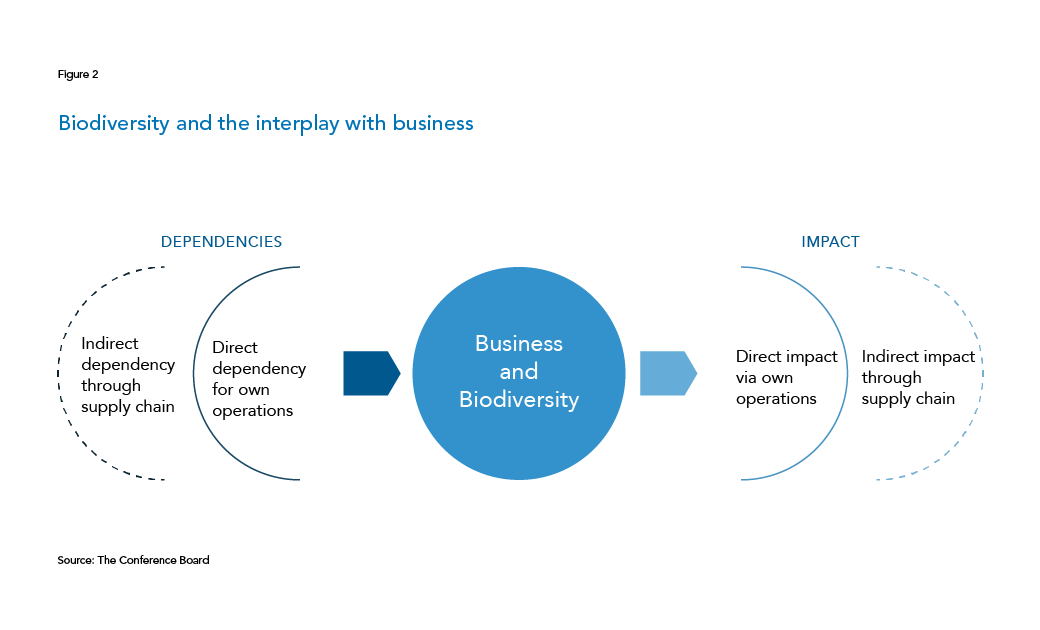Executive Summary
As we look beyond the COVID-19 pandemic, we see a strong case for addressing biodiversity loss and building more resilient ecosystems. Companies that show leadership in biodiversity protection can not only become resilient but will also enjoy a competitive edge over their less adaptable peers.
Biodiversity is vital to most facets of our lives. We humans are part of, and fully dependent on, this web of life: it gives us the food we eat, filters the water we drink, and supplies the air we breathe.1 Biodiversity has cultural value to humans and is important for our mental and physical well-being. It also holds significance for potential benefits such as new medicines and is critical for our society’s ability to cope with global change and health threats as highlighted by the COVID-19 pandemic. The risks associated with biodiversity loss are significant for companies across sectors. For example, biodiversity loss can lead to resource scarcity, supply chain disruption, increased operational costs, liability risks, or permanent loss of a resource or service, all of which can threaten future business operations. However, few companies have policies aimed at protecting biodiversity or recognize the financial risk they face.2 As we look beyond the COVID-19 pandemic, we see a strong case for addressing biodiversity loss and building more resilient ecosystems.
The term “biodiversity” was coined in 1985 and is a contraction of “biological diversity.” It refers to the variety of life on Earth, in all its forms—diversity within species, between species, and of ecosystems—and all its interactions.
Insights for What’s Ahead
New global targets for protecting biodiversity are on the horizon. Under the leadership of the United Nations, a key accord for nature—like the Paris Agreement—is expected to be reached at the Conference of the Parties (COP 15) to the Convention on Biological Diversity in October 2021 in Kunming, China. Countries are expected to agree on targets to protect the natural world, including proposals to conserve 30 percent of the world’s oceans and land by 2030, introduce controls on invasive species, and reduce plastics pollution. Given the cascading effect that such international accords can have on actions by regulators and other stakeholders who can place pressure on business, companies will want to follow the developments closely to be on top of what it means for them.
Even apart from any international accord, investors will likely put greater pressure on companies to address biodiversity loss and ecosystem impacts across their value chain. Investors are becoming increasingly concerned about the significant financial risks stemming from biodiversity loss and the destruction of natural ecosystems. Climate change and biodiversity loss are inextricably linked and need to be addressed collectively and interconnectedly.
“The world will not reach the goals of the Paris Agreement, let alone the aspiration to reach net zero emissions by 2050, without curtailing deforestation and accelerating protection and restoration efforts.”
Sandy Boss, Global Head of Investment Stewardship, BlackRock3
Further, with the introduction of biodiversity-related reporting requirements (e.g., EU Sustainable Finance Disclosure Regulation), companies will be progressively required to disclose their approach to managing material biodiversity and ecosystem business risks, and they can also expect shareholder proposals addressing this topic.
Addressing biodiversity risks can increase resilience and could bring new business opportunities. Business operations regardless of sector (e.g., food and beverage, construction, utilities, automotive, and travel and tourism) have a direct or indirect negative impact on biodiversity. Direct impact originates typically from land use, waste generation, air pollution, water pollution, and soil contamination, whereas indirect impact occurs upstream (third-party suppliers) and downstream (product use by consumers) in the supply chain. Firms that proactively identify risks and avoid or mitigate impact will be better prepared to navigate biodiversity-related physical and transition risks than those that do not. As a rule of thumb, companies should consider how and to what extent they can avoid biodiversity loss, reduce current impacts, seek to regenerate and restore ecosystems, and align their business model and biodiversity aims.
Businesses will chart their own journey to biodiversity protection depending on their sector, level of impact, and degree of dependency. Understanding how biodiversity relates to their business and where its impacts are largest can help executives shape their biodiversity and ecosystem services protection program. Some common elements define any biodiversity and ecosystem services program, and a good course of action is to: 1) assess the company’s impacts; 2) define the scope of the program; 3) integrate the approach into the company’s decision-making and implement the program; 4) measure and monitor the impacts; and 5) communicate the progress. While the importance of addressing biodiversity will vary by company, it is useful to assess management’s level of competence and expertise in this area, as well as to consider how to increase board familiarity with the subject.
Biodiversity and ecosystems play an important role in company value creation. Companies that show leadership in biodiversity protection can not only become resilient but will also enjoy a competitive edge over their less adaptable peers.












